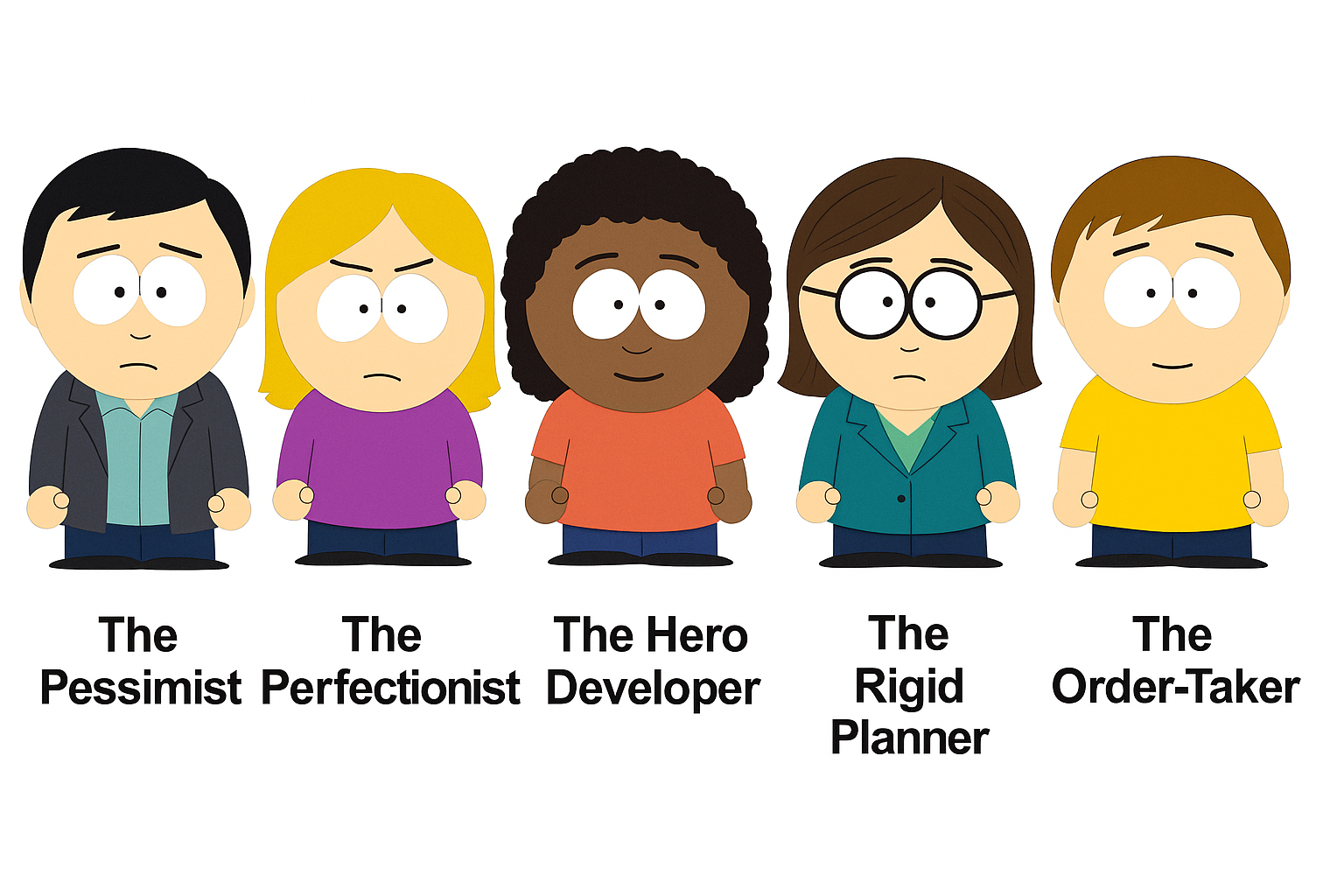“Why do we have to change? Everything has been working fine.”
– Said Every Scrum skeptic, ever
Scrum has been around longer than Agile itself, yet Scrum still faces resistance after more than thirty years.
If you've ever led or coached through a Scrum adoption, you've met at least one of these personalities. Some people thrive in an environment of transparency and self-management. Others prefer command-and-control, rigid roles, or the perceived safety of a Gantt chart.
Based on my experience, roughly 10 to 20 percent of people in an organization may actively or passively resist the transition to Scrum, sometimes permanently.
Let’s meet them and figure out the right conversations to have when faced with opposition to adoption.

🧠 The Pessimist
Mindset: “This Scrum thing is just another fad. And isn't Agile dead anyway?”
Why they resist: They’ve seen trend-driven transformations fail before and assume this one will too.
Hidden fear: Hope leads to disappointment. It feels safer not to try.
🎯 The Perfectionist
Mindset: “We can’t show this yet. It’s not perfect.” "Let's get the signoff on the UX design before we go any further."
Why they resist: Scrum’s iterative and incremental delivery and tolerance for early failure clash with their standards.
Hidden fear: Being judged on incomplete work or needing to rework it.
🦸 The Hero Developer
Mindset: “Just let me handle it. I’ll take care of it tonight.”
Why they resist: They thrive on saving the day and prefer solo ownership over team collaboration.
Hidden fear: Losing individual recognition in a cross-functional, team-driven environment.
📋 The Rigid Planner
Mindset: “Can you send me the detailed Product Backlog and the six month release plan?”
Why they resist: They seek certainty, fixed scope, and long-term predictability.
Hidden fear: Being held accountable without a clear, upfront plan.
🧾 The Order-Taker
Mindset: “Just tell me what to do.”
Why they resist: They’re used to following orders, not solving problems or making decisions.
Hidden fear: Making a mistake, having to learn something new, or being blamed for failure.
🛠️ How Scrum Masters Can Help
Scrum Masters are change agents, not just meeting facilitators. Here’s how they can support individuals who resist Scrum:
✅ Create Psychological Safety
People resist when they fear embarrassment or exposure.
Normalize failure and model curiosity over judgment.
Make it safe to speak up and experiment.
✅ Coach Toward Empowerment
Help people think, not just comply.
Ask questions like: “What would you try if failure wasn’t a concern?”
Promote small, safe-to-learn experiments.
✅ Expose Systemic Pressures
Resistance is often structural, not personal.
Make leadership behaviors and organizational contradictions visible.
Educate stakeholders on how control-based habits reduce agility.
✅ Set Boundaries Around Dysfunction
Self-management does not mean tolerating sabotage.
If someone repeatedly blocks improvement, raise the concern appropriately.
Support individuals, but protect the team’s ability to deliver.
✅ Use the Scrum Framework as a Mirror
Scrum does not solve problems. It reveals them.
Sprint Reviews expose misalignment.
Retrospectives uncover hidden fear, fatigue, or lack of support.
🧩 Help People Understand the “Why” Behind Scrum
Before people can commit to change, they need to understand the purpose. Too often, organizations jump straight into mechanics—Sprints, Daily Scrums, Product Backlogs—without ever explaining the reasoning.
How Scrum Masters can clarify the “Why”:
Connect Scrum to business goals
Help teams see Scrum as a way to deliver value early, get feedback quickly and adapt more easily, and solve real customer problems.Translate Agile values into everyday terms
“Responding to change” is not just a principle. That is how your organization stays relevant and competitive.Highlight the pain points Scrum addresses
Is work constantly reprioritized? Are customers frustrated? Scrum brings transparency, focus, and accountability.Share success stories
Use real-world examples, especially from similar roles or teams, to build credibility and engagement.Invite reflection instead of demanding compliance
Ask: “What frustrates you most about how we work today?”
Or: “What would better collaboration look like to you?”
Let people draw their own conclusions.
When people understand the why, they are far more likely to engage with the how.
🧭 Final Thoughts
Scrum is not for everyone, and it presents challenges for many organizations. It challenges ego, reveals dysfunction, and demands vulnerability. But for those willing to grow, it leads to clarity, autonomy, and continuous learning.
If you are a Scrum Master, your job is not to please the Hero Developer or pacify the Order-Taker. Your job is to serve the team, foster empiricism, and remove the obstacles, even when the obstacle is a mindset.
